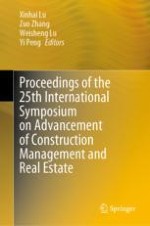2021 | OriginalPaper | Buchkapitel
Influence of Prefabricated Building Incentive Policy on Project Implementation Effect
verfasst von : Qingxiang Su, Shaoyan Wu, Pan Xing
Erschienen in: Proceedings of the 25th International Symposium on Advancement of Construction Management and Real Estate
Verlag: Springer Singapore
Aktivieren Sie unsere intelligente Suche, um passende Fachinhalte oder Patente zu finden.
Wählen Sie Textabschnitte aus um mit Künstlicher Intelligenz passenden Patente zu finden. powered by
Markieren Sie Textabschnitte, um KI-gestützt weitere passende Inhalte zu finden. powered by
